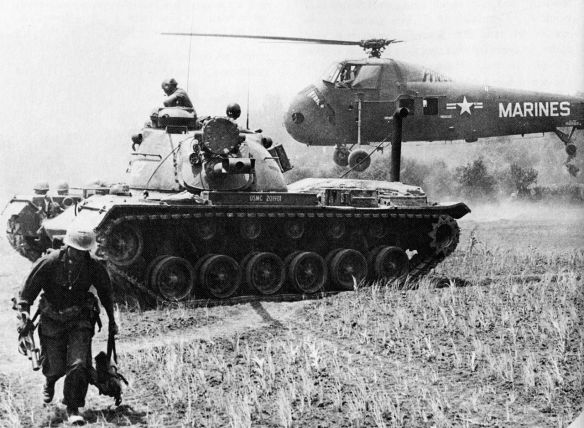Operation Starlite was the first offensive military action conducted by a purely U.S. military unit during the Vietnam War. The operation was launched based on intelligence provided by Major General Nguyen Chanh Thi, the commander of the South Vietnamese forces in northern I Corps area. Lieutenant General Lewis W. Walt devised a plan to launch a pre-emptive strike against the Viet Cong regiment to nullify the threat on the vital Chu Lai base and ensure its powerful communication tower remained intact.
The operation was conducted as a combined arms assault involving ground, air and naval units. U.S. Marines were deployed by helicopter insertion into the designated landing zone while an amphibious landing was used to deploy other Marines, including a flamethrower platoon.
A number of individuals argued at the time and since that strategic options were open to the United States in 1965 and afterwards that would have brought military victory. Two would have shifted resources towards more conventional warfare: an invasion of North Vietnam or an incursion into Laos to the Thai border to seal the frontier between North and South Vietnam. Two others were an enclave strategy and the demographic frontier.
General Maxwell Taylor, a strong advocate of an invasion of North Vietnam, argued that the United States “should never have put a soldier into South Vietnam”. Instead it “should have gone directly to Ha Noi by amphibious/airborne landing”. The Johnson Administration strongly opposed this, fearful that it would provoke a direct Chinese military intervention in the fashion of the Korean War. Throughout the Vietnam War the Pentagon brass was preoccupied with monitoring the Chinese military presence in North Vietnam and determining its strength and intentions. At all costs Washington wanted to avoid a military confrontation with China.
The plan would also have required substantial US military resources and there is nothing to indicate that it would have worked out any better than it had for the French, and certainly it would have increased US casualties. Also, even without a direct military intervention in Vietnam, China could have easily supplied PAVN forces in base areas along its southern border.
The invasion of Laos has been the most discussed option in retrospect. Colonel Harry Summers argued in his book On Strategy, A Critical Analysis of the Vietnam War that it was the best chance for a US military victory. In 1965 ARVN General Cao Van Viên suggested fortifying a zone from Ðông Hà in Vietnam to Savannakhet on the Lao—Thai border, with a landing to the north at Vinh or Hà Tinh in North Vietnam to cut off PAVN forces to the south. In August 1965 the Joint Chiefs developed a similar DMZ plan. Westmoreland proposed much the same in April 1967, although his plan included Viên’s amphibious landing north of the DMZ.
Its advocates argued that the line could easily have been held by eight divisions—five US, two Republic of Korea (ROK), and one ARVN—and that this would have cut the flow of men and supplies to the South, isolated the battlefield and allowed the ARVN to carry the brunt of the war against the VC. But it would also have entailed staggering logistics problems and required large numbers of support personnel (18,000 engineer troops alone). Besides, Communist forces in the South obtained the bulk of their resources within the South, and pulling US troops to the northern barrier would speed up the disintegration of the RVNAF. There was also every likelihood that Communist forces would simply skirt the barrier by going around it to the east through Thailand.
The last two strategies emphasizing counter-insurgency operations offered greater promise. The enclave strategy called for US forces to be concentrated in the population centres and coastal bases, freeing up ARVN to carry the brunt of the fight against the Communists. US forces might also be committed if opportunities for decisive pitched battle occurred. Although this strategy would have ceded the strategic initiative to the Communists and would not have taken advantage of the chief US strengths of firepower and manoeuvreability, in hindsight it probably offered the best hope of buying time to train the ARVN. And, by reducing US casualties, it would have minimized political pressure in the US for a withdrawal.
The final strategic option was proposed in 1968 after three years of US combat involvement. It called for denying the Communists access to the bulk of the population by concentrating US forces in pacification efforts along the coastal plain. This option, which placed greater emphasis on defeating the insurgent threat, had the same advantages as the enclave strategy of buying time for ARVN and reducing US casualties. In the final analysis those policies that increased the effectiveness of the South Vietnamese military and government probably held the best hope of defeating the Communists.
But in 1965 Washington’s response was to fall back on “graduated response” or slow escalation as the strategic answer, while within Vietnam Westmoreland placed priority on an attrition strategy of seeking out and destroying PAVN/VC units. Westmoreland had little patience for pacification. His big unit operations meant that US troops were not in any one area long enough to become familiar with it or to develop a close relationship with its people. As Krepinevich has noted, “It was far easier to fall back on the logistical and technological elements of strategy—sensors, ground radars, firepower on call, helicopter gunships, herbicides and defoliants—all of which gave the Army the opportunity to wage counterinsurgency American style.”
